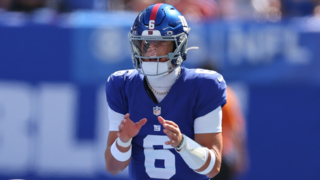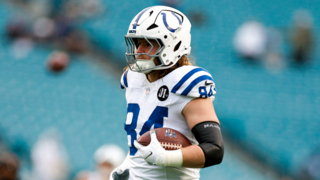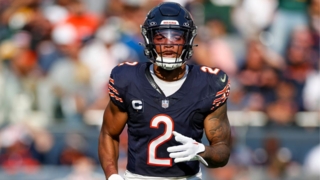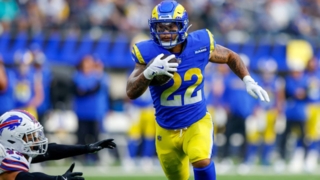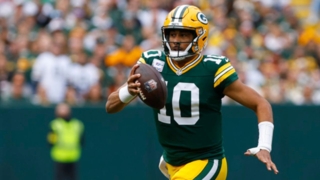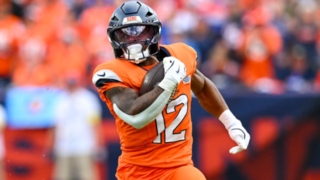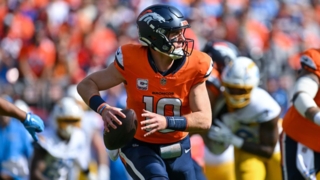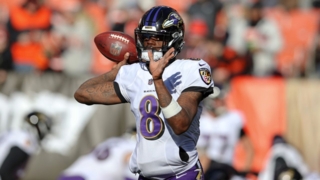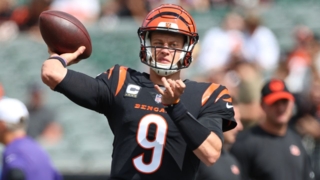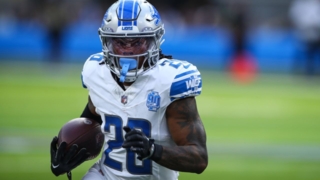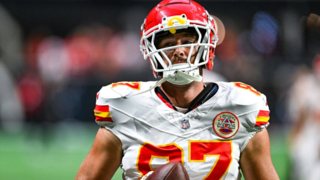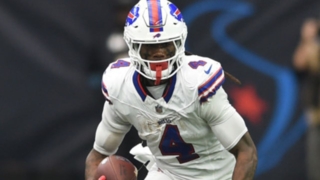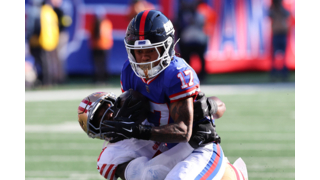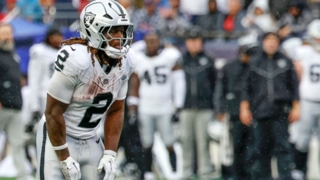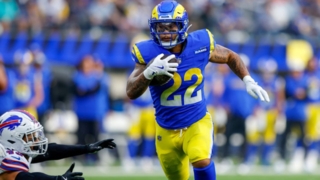First Best Ball Draft Recap of 2025

Picks, Strategy from Best Ball Tournament Draft
I love drafting more than most things in my life.
(Don’t worry. Wife and kids also rank high.)
So I’d prefer to be on the clock in some fashion, basically from the moment best ball drafts go live until September kickoff. But there’s one problem: I don’t have unlimited funds.
If you’re like me in that way, then it’s important we figure out where and how to compete this time of year.
And regardless of your funding situation, you should be trying to identify and leverage any specific advantages.
Why This Tournament?
You might think this is a bad time of year to draft. Not only are we still months away from the NFL Draft. But free agency hasn’t happened yet.
There’s so much we don’t know about the coming season at this point in the year. And that’s not even considering potential offseason and training camp injuries.
That all makes it my favorite time of year to draft.
(Enough intro. Take me to the picks.)
Take Advantage
I believe I’m better than most drafters at identifying things such as recency bias that will impact drafting throughout the offseason – and even more so the closer we are to the just completed season.
I’ve spent years making early projections and predictions for the following year.
I’ve got Jared on my side already working through 2025 team-by-team projections, pulling out trends and details from 2024.
I’ve got Shane providing evaluations on the incoming rookies that I – and most other drafters – barely know at this stage.
And I’ve got Kevin’s experience – especially with FFPC drafting – to help sharpen strategies.
Tourney Specifics
We are recapping an FFPC best ball draft in this article. That means the well-known TE-premium: 1.5 points per TE reception, compared with 1 point per reception for the other positions.
That obviously boosts TE values here and pushes the position earlier in drafts. But it’s also a quirk that can be overvalued. And I like any sensible scoring rule that runs against common formats.
They introduce more thinking into your drafting. More of a challenge. And the more challenging the draft, the greater the opportunity to seize advantages.
I don’t love that this contest – the Never Too Early Best Ball Tourney – uses playoff weeks instead of full-season scoring. Playoff weeks add a layer of luck to the outcomes by accentuating individual weeks.
But the early timing means none of us can actually draft to the specific playoff weeks yet. We don’t know the schedules or the bye weeks. And the $125 entry fee plus a smaller field (1,728 entries) means a lot less high-volume drafting.
I also like the advance rates here:
- Two of 12 teams advance after Week 14 (pretty standard)
- Three of 12 advance after Week 15
- Three of 12 again after Week 16
- And then you get a mere 18-team final
That’s far different from the thousands down to hundreds of competitors on Underdog – many of whom draft 100+ entries into multiple contests.
Proven Results
Perhaps the biggest reason I keep playing this one, though, is that I’ve done well in it.
The first year, 2022, I advanced both entries. And one of those took fifth overall.
So far, I’ve advanced teams to the playoff rounds in each of the three seasons, despite not yet playing more than six entries in any of the tournaments.
What’s In This For You?
Even if you don’t care about my results and don’t plan to play this contest, you should be able to find some useful info in the analysis below.
The strategies and player ordering in play here will still apply to formats that don’t include TE-premium scoring and use different lineup structures.
And I’ll dig into some of the reasons that I selected certain players.
If you’d like to see the full board from this draft, you can find it here.
Opening Strategies
I don’t like to enter a draft with a rigid plan. I want to stay flexible. Of course, that itself counts as a strategy.
Just check the “core strategies” in our Best Ball Strategy article and you’ll find:
Leverage the value your draft presents.
You don’t want to draft a best ball tournament team the same way you would a lineup-setting roster. But you can also get into trouble by adhering too closely to roster-building “rules” or – especially – chasing what worked for last year’s winners.
Here are some other strategies I’m taking into these drafts with me:
Build stacks but don’t reach for them. We know stacking matters for these contests. That’s especially true with the playoff weeks. But if we reach too far to complete those stacks, we counter the value advantage they deliver.
Take advantage of recency bias. I already mentioned that above, and it’s not difficult to see anytime you look at early ADP – or even any individual draft board. If you can push yourself beyond recency bias even a little, you’ll be ahead of the field this time of year.
Leverage ADP fluctuations. This time of year, it’s primarily about getting ahead of those fluctuations. I’ll hit on some guys I expect to move up or down in ADP as we move through the picks below.
OK, enough excessive backstory. Let’s get to the recipe.
Here are the 20 players I picked for my first best ball tournament entry of 2025 – and why I picked them …
Rounds 1 and 2
1.12 Malik Nabers, WR, New York Giants
2.01 Christian McCaffrey, RB, San Francisco 49ers
Opening Strategy
I basically want the two best players that reach me here. That could be a WR and a RB, two WRs, or maybe a WR and a TE if Brock Bowers or Trey McBride gets here.
I’m less likely to double up at RB – primarily because that hinders my flexibility over at least the next few rounds.
(More on that later …)
That might change a little this year, though. This draft went RB-heavy in Round 2 (eight of them). And by my third-round turn, 14 RBs had left the board vs. 16 WRs.
Similarly, early Underdog Fantasy ADP finds 11 RBs and 12 WRs among the top 24 in overall ADP.
That said, if more drafters are taking early RBs, then it might be a good year to lean the other way and open more tournament drafts going WR-heavy.
This draft found four teams taking two RBs among their first three picks and eight teams with two RBs rostered by the end of Round 4.
Nabers at WR7; McCaffrey at RB4
I don’t think my player choices require much defense.
Nabers proved excellent and a target hog right away, despite getting garbage QB play.
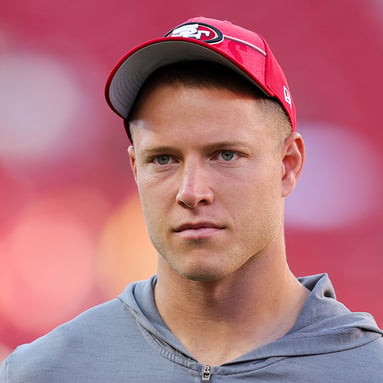
McCaffrey was a top-3 pick in just about every draft last year and should be healthy for 2025. Maybe I’ll look stupid if he’s having more calf trouble by August. But we’re already seen that the ceiling here is dominating the position.
Rounds 3 and 4
3.12 D.J. Moore, WR, Chicago Bears
4.01 Marvin Harrison Jr., WR, Arizona Cardinals
Strategy
The volume of RBs in Round 2 – plus a pair of QBs and the third TE off the board – helped push some team WR1s to this turn.
I considered Mike Evans, Jayden Daniels, and stacking Jalen Hurts with DeVonta Smith at this turn. I’d probably mix in Evans some if facing this decision multiple times.
Daniels would have been more attractive if Terry McLaurin hadn’t gone the pick before my turn. I’m not saying I won’t take Daniels without McLaurin available. But I know I’d be competing in the playoff rounds with other Daniels teams that do have his No. 1 WR stacked.
Hurts and Smith would similarly be fine but the upside limited in a run-heavy offense that still treats A.J. Brown as the No. 1.
Moore, Harrison as WRs 17-18

So I opted for No. 1 WRs from Chicago and Arizona, with potential QB stacks that I knew would stick around longer than Hurts – and probably longer than Baker Mayfield (for Evans).
Harrison’s rookie year looked disappointing vs. a 2024 ADP that I always thought was too high. But he finished a decent WR30 in total PPR points and outscored these fellow former first-round NFL Draft WRs in points per game:
- Michael Crabtree
- DeVonta Smith
- Calvin Johnson
- Drake London
- DeAndre Hopkins
- Jaxon Smith-Njigba
Harrison and his usage will need to improve to deliver upside vs. a WR18 draft position. But the potential’s there.
Other Options?
I want to collect multiple team WR1s in this range. I believe the 10 WRs who went between my Round 4 pick and my Round 5 turn support the Moore-Harrison double-tap:
- Mike Evans
- Rashee Rice
- Zay Flowers
- Davante Adams
- Xavier Worthy
- George Pickens
- DK Metcalf
- Courtland Sutton
- Jaylen Waddle
- DeVonta Smith
- Jameson Williams
- Jordan Addison
- Chris Godwin
Rounds 5 and 6
5.12 T.J. Hockenson, TE, Minnesota Vikings
6.01 Isiah Pacheco, RB, Kansas City Chiefs
Strategy
The FFPC format (1.5 points per TE reception) obviously increases TE impact quite a bit. I’m not sure that alters the strategy for the position as much as you might think, though.
Sure, it means TEs will collectively get drafted earlier. But my general best ball goal at the position is to land a top-level guy at reasonable cost or wait and collect stacks/upside options.
What I definitely don’t want to do is find myself chasing the rest of the league.
Hockenson a Value?

The Vikings TE was going much later in last year’s drafts, of course, because he was coming off a Week 16 ACL tear.
The year before that, however, found Hockenson third among TEs in ADP. And he paid off, tying Travis Kelce for the position’s lead in points per game.
He got a boost from Justin Jefferson missing seven games. Hockenson’s PPR scoring average for the seven healthy games he shared with Jefferson would have tied for sixth in scoring average.
Ultimately, I don’t think Hockenson carries upside to the top of the position without a Jefferson injury. So he’s fine in this range – but not a value. I’ll mix him in rather than specifically targeting him.
Another three TEs followed in Round 6, and then four more in Round 7. So I’d have been looking at TE13 by my Round 7 turn.
Pacheco Too Risky?

Like Hockenson, Pacheco will go later in 2025 drafts than he did entering his last healthy season.
The Chief was going 10th or 11th among RBs in ADP last summer. Then he racked up 17 and 24 touches the first two weeks. And a broken leg.
We’ve gotten a much more limited version of Pacheco since his return.
Is that just a matter of working back from an injury that cost him 11 weeks in the middle of the NFL season? Will the Chiefs limit his work more in 2025?
We’ll learn more about that by how the team addresses the position this offseason.
If the Chiefs draft or sign a significant RB, then Pacheco’s ADP could dip further. If they get to May with no Hunt nor key addition, however, Pacheco could easily rise.
Other Options
James Conner was the only RB to follow Pacheco in Round 6. I’m fully prepared to feel remorse over choosing Pacheco ahead of Conner.
Tyrone Tracy and 2025 rookie Omarion Hampton went in Round 7. I’ll take Pacheco over both – at least until Hampton gets a landing spot.
Rounds 7 and 8
7.12 Deebo Samuel, WR, San Francisco 49ers
8.01 Jakobi Meyers, WR, Las Vegas Raiders
Strategy
As I’ve mentioned multiple times already, I like to stay flexible through the single-digit rounds.
If I open my draft with two RBs, I’m making the bet (by virtue of capital spent) that both guys will stay healthy and deliver fantasy points for me all year.
In that scenario, I should follow double-RB picks by focusing on other positions over the next few rounds and avoiding RB. I wouldn’t have taken (or Conner). And I’d be taking on more risk at WR by mixing in QB or TE in that range.
The way this draft played out, though, I get to the 7-8 turn with options.
Why the Two WRs?
First, what else might I have done here? If I had passed on either WR, then it likely would have been to stack a QB with a WR I already had.
At this turn, that would have meant either Kyler Murray or pairing Samuel with Brock Purdy.

Just six QBs had left the board before my turn. QB7 would be OK for Murray, but I don’t think his upside reaches much beyond that. And Harrison can pay off for me without Murray posting a monster season.
Purdy probably would have made more sense. Adding Samuel to McCaffrey on this roster already signals a bet on the 49ers offense – unless the 49ers move Samuel.
Ultimately, QB7 hit me as a bit early for Purdy as well – especially with a decent shot he’d get back to me in Round 9.
Meyers a Value; Samuel an Upside Play
So I took these two wideouts as the 43rd and 44th players at the position.
Meyers finished last season 24th in PPR points per game. He finished the previous season tied for 28th. And from Week 8 on last season – after the Davante Adams trade – Meyers ranked 19th among WRs in PPR points per game and tied for 11th in expected points per game.

That he’s available in WR4 range is absurd.
Samuel, meanwhile, is coming off a career low in fantasy points per game. But he’s just 29 and posted the second-best per-game average of his career in 2023 (ranked 14th among WRs).
He seems like a solid gamble at this level – and still a potential stack with Purdy.
Meh WRs Followed
Amari Cooper was the only WR to join Meyers in Round 8. Only Khalil Shakir and rookie Luther Burden III went among WRs in Round 9.
I’ll happily take Samuel and Meyers over those guys. So I like my timing, even in hindsight.
Rounds 9 and 10
9.12 Caleb Williams, QB, Chicago Bears
10.01 Drake Maye, QB, New England Patriots
Strategy
Neither Purdy nor Murray made it back to me. Murray went at 8.04. Purdy teased by lasting until three picks before this turn. He went 13th among QBs.
Did I make a mistake by passing on both at the last turn? Final results will tell, of course. But I think the process was fine.
Grabbing WRs last turn gives my roster five team WR1s. (I guess Samuel’s inclusion there is arguable.) And I still managed to stack an upside QB (Williams) with my Round 3 WR (Moore).
Why Double Up at QB?
Waiting on QB is fine. But if you wait until this range for your first QB, then you should take your second soon thereafter.
Why? Unless one of the QBs you draft dramatically outperforms his draft position – and other QBs talent earlier – then you’re simply chasing likely better QB production on other teams in your group.
That’s easier to counter by combining weekly production for a pair of QBs in this range than if I were to wait again and cross my fingers with each QB.
Is Maye Gonna Be a Value?
Maye finished his rookie season outside the top 30 in fantasy points per game. But that’s because he saw limited action in three of those 13 contests.

His scoring average across 10 full outings would have ranked 14th at the position for the season. I got him as the QB16 here.
And the weakness of his 2024 pass-catching options means there will be late-round stack opportunities.
Should I Have Gone RB?
Rhamondre Stevenson went with the next pick of Round 10, as RB35. Tyjae Spears went later in Round 10, as did the Jaguars’ top 2 (current) RBs.
Should I have taken one of those guys instead of a second QB? Maybe.
But I didn’t finish this draft disappointed with my decisions here.
Rounds 11 and 12
11.12 Hunter Henry, TE, New England Patriots
12.01 Jaylen Wright, RB, Miami Dolphins
Strategy
Good time to stack.
Twelve TEs had left the board before my Round 9 turn. Another six went between my Maye selection and this turn.
I’m pleased to get Henry here, both as the 19th TE in a TE-premium format – behind a top-5 first guy at the position (Hockenson) – and as a Maye stacking partner.

Otherwise, I knew I wanted at least one RB at this turn – with 40 off the board and just two on my roster.
Why Jaylen Wright?
I took the second-year Miami RB ahead of Rachaad White, who finished 21st among PPR backs despite getting overtaken by Bucky Irving.
Mistake? Maybe.
But White got very lucky on TDs last year (six scores among 51 receptions) and could barely be found in the offense by season’s end.
He collected just 7 touches in the Week 17 win over Carolina and then THREE in the Wild Card loss to Washington.
White’s trending down.
Wright ranked just third among Dolphins in carries after arriving as a fourth-round pick. But Raheem Mostert (33 in April) could be gone. And De’Von Achane might be maxed out at the 11.9 carries per game he averaged last season.
Which RBs Followed?
Cameron Skattebo, Trey Benson, and Blake Corum joined Wright and White in Round 12.
Jordan Mason, Javonte Williams, and Nick Chubb followed in Round 13.
I’m happy with the upside bet on Wright and the Miami run game here.
Rounds 13 and 14
13.12 Cole Kmet, TE, Chicago Bears
14.01 Ollie Gordon II, RB, Rookie
Strategy
I hit this turn planning to take at least one more RB … and happy to see recency bias working in my favor.
Kmet finished last season just 23rd among TEs in FFPC points per game. The year before, he ranked eighth; 16th in 2022.

I got him 22nd among TEs here, to stack with Williams. Under a new coaching staff. And quite possibly with both Gerald Everett and Keenan Allen gone.
We’ll See About Gordon
The rookie RB as pick No. 2 seemed like a good chance to take here.
Gordon’s coming off a disappointing 2024. But he led FBS in rushing yards and touches in 2023, averaging 6.1 yards per carry and delivering a 39-330-1 receiving line (at 8.5 yards per catch).
If he impresses at the Combine and generates some buzz, he could easily climb higher than his RB49 position here.
Rounds 15 and 16
15.12 MarShawn Lloyd, RB, Green Bay Packers
16.01 Dontayvion Wicks, WR, Green Bay Packers
Strategy
We’re obviously shooting for upside here. And one primary way we like to target late-round upside is to grab players with “non-obvious” opportunity. I think both of these Packers qualify.
Lloyd reportedly impressed last offseason after arriving as a Round 3 pick. But injuries kept him from getting on the field much in the regular season.
If he can stay healthy this year, he should stand a good chance of hitting September as the No. 2 behind Josh Jacobs, in a Matt LaFleur system that has typically supported fantasy value in two RBs.
Wicks gets an opportunity boost from Christian Watson’s ACL tear.

He has seen big upticks in usage when Watson’s been out the past two years. And the Packers like to throw him the ball when he’s out there.
Among 169 WRs who ran at least 50 routes last season, Wicks ranked fifth in targets per route.
He’s not a specific target for me in 2025 (at the moment, at least). But he makes plenty of sense in WR6-7 range (WR72 here).
Rounds 17 and 18
17.12 Jaxson Dart, QB, Rookie
18.01 Diontae Johnson, WR, Free Agent
Strategy
I’m most likely taking three QBs for every pre-draft best ball entry.
Besides the obvious injury protection, it’ll work as insurance against the chance that my first two wind up sharing a bye week. Plus, the fact that I waited on my QB1 adds value to mixing in a third QB for upside weeks.
The 20-man roster for 10 starting spots also helps allow room.
Dart’s most interesting because of his rushing: 1,915 yards and 12 TDs across his three years starting at Ole Miss, if you don’t subtract sack yardage. (Official NCAA stats do.)
Bonus here: If he lands with the Giants or Raiders, then I’ve got another QB-WR stack.
Johnson Worth the Risk
Perhaps Diontae Johnson’s attitude finally lands him with no team in 2025. But he got picked up every time a team quit on him in 2024.

Even after Houston dumped him, Baltimore scooped (probably) just to recoup the potential compensatory-pick value in case some other team signs him this offseason.
Johnson remains talented, doesn’t face any legal issues, and turns just 29 in July. So it’s not hard to imagine some team taking another shot on him.
If that doesn’t pan out, I haven’t lost much in wasting my 18th-round WR7.
But What About …
Should I have taken a different WR instead?
These WRs followed Johnson in Round 18:
- Tez Johnson
- Jaylen Royals
- Demario Douglas
- Dyami Brown
Perhaps I should have stacked Douglas with Maye instead. But he just finished a lackluster second season that revealed limited upside (5.9-yard aDOT, 9.4 yards per catch). There’s much more upside to Johnson.
Patriots RB Antonio Gibson did go off the board at 18.02, and I could see the argument for him being the pick at 18.01.
He had just one weekly finish higher than RB27 in 2024, though. Perhaps the new coaching staff helps Gibson. But the upside gap between him and Johnson is large as well.
Finally, if Johnson does sign somewhere in March or April, he’s likely to climb at least a few rounds up the draft board.
Rounds 19 and 20
19.12 Bhayshul Tuten, RB, Rookie
20.01 Kendrick Bourne, WR, New England Patriots
Strategy
It’s all upside here.
I like what Shane has said about Tuten, calling him a “sleeper to be an immediate contributor” in the NFL.
Kendre Miller, Jaydon Blue, Sean Tucker, and Kimani Vidal followed him here. Jaleel McLaughlin, Justice Hill, Kyle Monangai, Zack Moss, and Gus Edwards sat among the undrafted RBs at the end of this one.
You could argue any members of that group in place of Tuten if you want. We’ll see how the next two months go.
Interesting Stack
You might think it’s a stretch to call Bourne “interesting.” But I think he is for a few reasons:
- Obviously, he stacks with Maye.
- Last time Bourne worked with recurring Patriots OC Josh McDaniels (2021), the WR:
- Caught a career-high 55 balls
- Tallied a career-high 800 receiving yards
- Tied his career high with 5 TD receptions
- Trailed only Jakobi Meyers in catches and yards.
- He’s likely to go unselected in most of this tournament’s drafts.
New England could save $5.1 million in cap space by dumping Bourne, according to Spotrac. But the team’s already awash in 2025 cap room.
So I’ll take a shot on a 20th-round veteran WR stack who should be lightly owned.
Who Else Went Undrafted?
Besides the RBs I mentioned above, here are some notable players by position who didn’t land on a team in my draft
QB
- Aaron Rodgers
- Jameis Winston
Rodgers carries retirement risk but would obviously start somewhere if he plays. Winston reminded us how high his fantasy ceiling goes. Even the Browns didn’t want to keep him in the lineup, though.
RB
- Alexander Mattison
- Khalil Herbert
- Sincere McCormick
- LeQuint Allen Jr. (rookie)
- Damien Martinez (rookie)
- Kenneth Gainwell
- Elijah Mitchell
The rookies here are worth considering in the late-round mix, at least while we wait to learn more about their NFL outlooks.
Among the non-rookies, only McCormick doesn’t hit free agency in March.
None of these RBs currently qualifies as a guy that should have been drafted, as far as I’m concerned.
WR
- Michael Wilson
- Gabe Davis
- Tank Dell
- Devaughn Vele
- Troy Franklin
- Ja’Lynn Polk
- Javon Baker
Michael Wilson Mistake?

The Kyler Murray team in this draft chose only to stack Trey McBride with him. But the team did also draft five rookie WRs.
Sure seems like that drafter is expecting the Cardinals to draft someone who will quickly overtake Wilson. That wouldn’t shock me. But creating scenarios like that can also work against you in these early drafts.
It’s simply statistically way more likely that Wilson opens the season on Murray’s team than any of the rookies joining the QB. Because Wilson’s already on that team.
I’d have subbed in Wilson for one of those rookies.
By the way, that same team also drafted three rookie RBs and a rookie TE. That’s NINE rookies on a 20-player roster. Overkill.
Other Guys
Dell unfortunately makes sense as a pass. We have no idea if his injured knee will be ready at any point in 2025. And what’s the ceiling even if he does play?
The second-year Patriots look a little interesting just because we don’t really know how that WR corps will shape up for 2025. Polk endured a poor rookie showing, though, and Baker barely saw the field.
Vele and Franklin didn’t land among the 91 WRs drafted even though each played more snaps as a 2024 rookie than teammate Marvin Mims did in his second season. (Mims went 60th among WRs in this draft.)
Davis is not exciting at all, but we had 13 rookie WRs drafted, along with plenty of other second- and third-year guys who have fewer spike weeks behind them than Davis.

There’s little risk to stacking Trevor Lawrence (QB23 in this draft) and Davis this season.
The Lawrence drafter in this one took Jalen Tolbert as the 87th WR in Round 19 – without Dak Prescott rostered. Why not take Davis – or one of the Broncos WRs to stack with Bo Nix – instead?
TE
The most prominent name I found that didn’t go among the 41 TEs drafted was Tyler Conklin. So let’s say this draft fared OK at the position.
More Best Ball Strategy Talk
Matt and Jared Talk More Best Ball Strategy
Draft using the best dynamic tool in the industry. Our fantasy player valuations (3D Values) change during your draft in response to...
- Exact league settings - direct sync
- Opponent and Team Needs
- Positional scarcity & available players
- Ceiling, injury risk, ADP, and more!
You need a dynamic cheat sheet that easily live-syncs with your draft board and adapts throughout your draft using 17 crucial indicators.
Get your Draft War Room Today
 Redraft
Redraft Dynasty
Dynasty Best Ball
Best Ball
